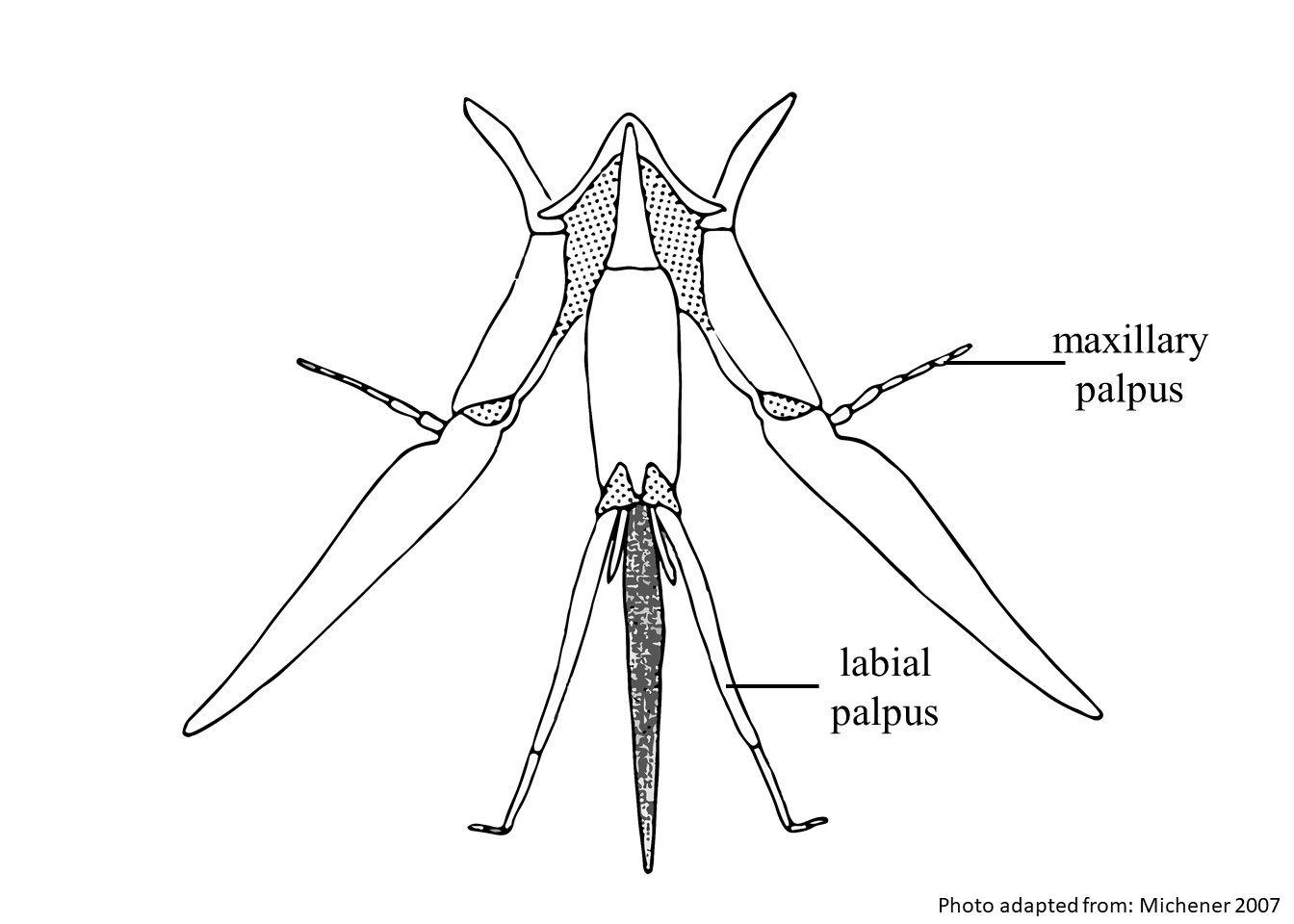Family: Megachilidae
Subfamily: Megachilinae
Tribe: Osmiini
Genus: Osmia Panzer, 1806
Subgenus: Hoplosmia Thomson, 1872
Common name: none
Osmia (Hoplosmia) are robust, non-metallic bees with white to yellow hairs that form tergal fasciae (Michener 2007Michener 2007:
Michener, C.D. 2007. The Bees of the World (2nd ed.). Johns Hopkins University Press, Baltimore and London, 953 pp.; Müller 2018a). They range in body length from 5–11 mm (Müller 2018a).
(modified from Müller 2018a, unless otherwise stated)
 are four-segmented (Michener 2007Michener 2007:
are four-segmented (Michener 2007Michener 2007: usually has a spine. The shape is species-dependent.
usually has a spine. The shape is species-dependent. with a crenulatecrenulate:
with a crenulatecrenulate: sometimes laterally toothed (Michener 2007Michener 2007:
sometimes laterally toothed (Michener 2007Michener 2007:Osmia (Hoplosmia) may be confused with some species of Heriades (Heriades) due to the spined axillae, which are uncommon among Osmiini (Müller 2018a). Osmia (Hoplosmia) can be differentiated from Heriades because O. (Hoplosmia) lacks a distinct transverse carinacarina:
a clearly defined ridge or keel, not necessarily high or acute; usually appears on bees as simply a raised line
that delimits the basalbasal:
originating at the foundation of a structure
area of the propodeumpropodeum:
the last segment of the thorax
from the steep vertical slope of the propodeumpropodeum:
the last segment of the thorax
. O. (Hoplosmia) females do not have the preapicalpreapical:
referring to a section of a bee that is physically found just before the outermost (or apical) end of the section or segment
tuft of long erect hairs on the labrumlabrum:
part of the head abutting the clypeus, folds down in front of the mouthparts
 that is present in Heriades (Müller 2018a).
that is present in Heriades (Müller 2018a).
Osmia (Hoplosmia) are predominantly specialists on Asteraceae. Many species have a preference for Cichorioideae, Asteroideae, and Carduoideae. Unlike many other O. (Hoplosmia), O. fallax are generalists with a preference for Cistaceae, Asteraceae, and Brassicaceae (Müller 2018b).
Osmia (Hoplosmia) have been observed nesting in snail shells, abandoned insect burrows, hollow stems, and cavities in soil and rocks. Osmia croatica nest in snail shells that are hidden under rocks. Cell partitions and nest plugs are comprised of masticated leaves. Osmia spinulosa nest in snail shells. After their nest is complete, they turn their snail shell nests so the shell opening is directed towards the ground. Cell partitions and nest plugs are comprised of masticated leaves. Osmia anceyi nest in insect burrows in dead wood and pithy stems. Cell partitions and nest plugs are comprised of mud with the occasional mixture of pith. Osmia bidentata nest in insect burrows in dead wood, hollow stems, and cavities in soil. Cell partitions and nest plugs are constructed out of mud. Osmia distinguenda nest in small cavities in rocks. Cell partitions are constructed out of masticated leaves, while the nest plug is comprised of leaf pulp (Müller 2018b).
Osmia (Hoplosmia) contains 21 species (Müller 2018a), None are known to occur in the U.S. or Canada.
There are no known invasives.
Osmia (Hoplosmia) can be found throughout Europe, Asia, and northern Africa (Müller 2018b).

Distribution map generated by
Discover Life -- click on map for details, credits, and terms of use.
Michener, C.D. 2007. The Bees of the World. 2nd ed. Johns Hopkins University Press, Baltimore and London, 953 pp. Psyche 77: 190-201.
Müller, A. 2018a. Palaearctic Osmia bees of the subgenus Hoplosmia (Megachilidae, Osmiini): biology, taxonomy and key to species. Zootaxa 4415: 297-329.
Müller, A. 2018b. Palaearctic Osmiine Bees, ETH Zürich, http://blogs.ethz.ch/osmiini